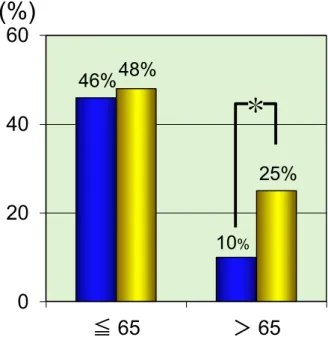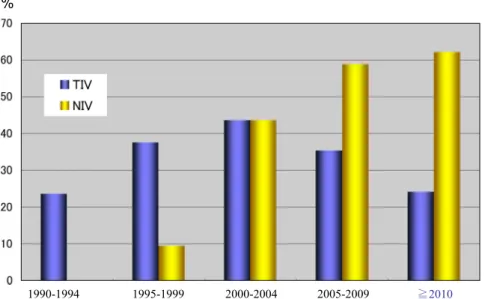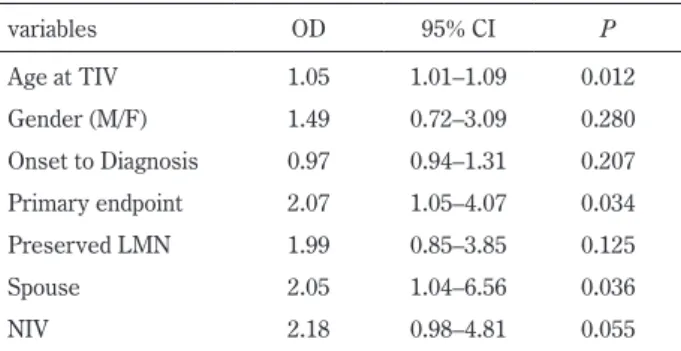はじめに
昔,結核が難病であったように,生活を豊かにし,公衆衛 生を向上させ医学の進歩により人類は難病を克服してきた. しかし,現在においても依然として原因不明の難病が存在す る.筋萎縮性側索硬化症(amyotrophic lateral sclerosis; ALS) は難病の一つで上下肢・球麻痺の進行に伴い呼吸不全に至る
致死的神経変性疾患である1)~3).その症状が進行する中,呼
吸不全が進行し非侵襲的人工呼吸器(non-invasive ventilation; NIV)や気管切開を伴う侵襲的人工呼吸器(tracheostomy and invasive ventilation; TIV)が生命維持のために必要となる.多 くの ALS は意識が清明で精神活動が正常なままで呼吸筋麻 痺への対応が求められる4).現在まで TIV 装着に至った ALS 症例に対する装着要因やその後の予後に関する統計的な検討 はほとんどなされていない5). 人工呼吸器装着問題 歴史を振り返ると,人工呼吸器が希少で使用に制限があり 呼吸器装着の選択肢すらなかった時代から,人工呼吸器が普 及したが本人・家族の意思を十分確認せず救急処置の一環と して TIV 装着が行なわれたこともあった6).その反省を踏ま え,呼吸器装着に対する事前意思確認の上で TIV 装着を行な うようになったのが 1980 年代後半から 1990 年代に掛けてで あった7).本稿の対象患者は 1990~2013 年までの自験例の データ解析で,大阪医科大学附属病院にて診断時から呼吸不 全に至るまで経過観察し,事前意思確認を行なった ALS 症例 190例(一部に 2010 年まで 160 例)を対象に検討した(除外 症例などの詳細は原著論文に記載8)). 2000 年前後の変化 1990年代を経てALSを支える医療環境は2000年前後で大き く変化した.リルゾール投与は 1999 年 3 月,日本で発売開始 され,その効果の程は限定的ではあるが ALS 患者に保険適応 が認められた唯一の薬剤として大きなインパクトを与えた. American Academy of Neurology(AAN)9)と World Federation of
Neurology(WFN)10)から ALS 治療ガイドラインが 1999 年に 発表され標準的治療が行われるようになった.その後,経皮 的胃ろう増設術(PEG)や NIV が多くの専門医療施設で普及 した.介護保険制度が 2000 年 4 月から導入され医療・介護・ 看護など多職種連携によるチーム医療が実践されるように なった11).2002 年日本神経学会治療ガイドライン(その後 2013年改訂版)が発表され,病因・病態・診断・鑑別診断・ 薬物療法・告知の方法に加えて 3 大ケアポイント(呼吸管理・ 栄養管理・言語),緩和ケア,支援ネットワーク,在宅ケアま で言及したものであった12).中でも嚥下・栄養管理の重要性 が強調された13).その他,カフアシストの保険適応(2010 年 要旨: 筋萎縮性側索硬化症における人工呼吸器装着は最も重要な治療手段選択の一つである.事前意思確認を 行なった 1990∼2013 年までの自験例 190 例の調査結果から,発症から診断までの期間,侵襲的・非侵襲的人工 呼吸器装着率,年齢による装着率の変化と推移および予後解析を報告した.その中で,1990∼2010 年までの 160 例について,侵襲的人工呼吸器装着による延命効果に影響する因子(年齢,配偶者など)を分析すると共に,侵襲 的人工呼吸器装着を決定する因子分析を行い,装着年齢,配偶者の存在,残存運動機能の有無,呼吸器装着までの 期間と診断時進行度などが関与することを示した.2010 年以後の侵襲的・非侵襲的人工呼吸器装着率の経時的分 析結果から,非侵襲的人工呼吸器装着率が年々増加する一方,侵襲的人工呼吸器装着率は減少傾向を示した.世界 における人工呼吸器装着率の現況を考察した. (臨床神経 2016;56:241-247)
Key words: 予後,陽圧式人工呼吸器,ALS 評価スケール,残存運動機能,レスパイト
*Corresponding author: 大阪医科大学内科学(1)神経内科〔〒 569-8686 大阪府高槻市大学町 2 番 7 号〕 1)大阪医科大学内科学(1)神経内科
(Received October 22, 2015; Accepted February 18, 2016; Published online in J-STAGE on March 30, 2016) doi: 10.5692/clinicalneurol.cn-000837
度),ALS 啓発活動(その後アイス・バケツ・チャレンジ), ヘルパーによる痰吸引の承認(2012 年)など社会的関心の高 まりがみられた. 当院における 2000 年前後の変化をみると ALS が発症して から診断に至るまでの期間は 2000 年以前が平均 15 ヶ月で あったのがそれ以後は平均 11 ヶ月へ短縮され早期に診断さ れる態勢は徐々にできつつあると考える(Fig. 1).また,多 くの施設において ALS 症例の平均年齢の高齢化が認められ た14)15).この原因は本邦における平均寿命の延長に伴って高齢 ALS症例が多く診断されるようになった結果と考える.具体 的には,脳卒中や心筋梗塞など致死的疾患の死亡が減少し神 経変性疾患の有病率が相対的に増加したことがあげられる. TIV 装着時の年齢(Fig. 2) 自らの意思で TIV を決定したのは 160 例中 52 例(33%)で 2010年以後では 30 例中 7 例(23%),合計では 31%であっ た.この数値は地域差や施設間格差こそあれ 2009 年全国で行 われた断面的調査報告(29%)16)とほぼ同様で専門施設にお ける日本の平均的数値と考えられる.その内訳を 2000 年前後 で比較検討すると,装着年齢が 65 歳以下の場合にはほぼ半数 で TIV 装着が行なわれた.一方,65 歳以上の群では 10%か ら 25%へと年代を経て TIV 装着率が増加した(P = 0.027). 高齢群における TIV 装着率上昇も日本全体の人口動態におけ る平均寿命延長が理由の一つと考えられる17). NIV の変遷 NIVは 1998 年から新たな治療法の一つとして保険導入さ れ当院では 2000 年以前には 5 症例のみであったが,2000 年 以降は ALS における標準的な補助呼吸治療法となった18).
NIVから TIV への変換については,すでに NIV を装着されて
いる症例は TIV 装着へ移行する傾向が認められた.人工呼吸 器のコンパクト化と共に,回路を変えるだけで TIV へシフト が可能な機種もあり,TIV 装着率を上げる要因の一つと推測 される.ただ,NIV 装着 ALS 患者の中で NIV 装着による延命 効果が長期に得られたため当初 TIV への転換を希望されたが 転換を断念された症例も見受けられた.特筆すべき傾向とし て,2010 年以後は NIV 装着率が増加し TIV 装着率が減少す る傾向があり今後注目される(Fig. 3). TIV・NIV による延命効果(Fig. 4) TIV装着なしでは死に至る時点を 1 次エンドポイント,TIV 装着後の死亡を 2 次エンドポイントとすると,2013 年まで 190症例の生存期間中央値は 1 次エンドポイント(32 ヶ月) に比べて有意に延長(75 ヶ月 P < 0.001)した.TIV 装着後 の死亡原因は肺炎・気胸・心不全・悪性腫瘍合併19)に加え原 因不明の突然死20)があり経過中に急性呼吸不全を呈した肺塞 栓も認められた21)22).NIV 使用による生存期間中央値は 43 ヶ 月,自然経過に比べ 11 ヶ月延長し有意な延命効果が得られた (P = 0.0014 NIV vs natural course).しかし,この効果は TIV に比べて有意に短かった(P = 0.003 NIV vs TIV).NIV は TIV のように呼吸を完全に維持バックアップするのではなく,あ Fig. 2. The choice (%) of TIV more than two decades before (blue box) and after (yellow box) 2000 divided into patients ≤ 65 or >65 years old at the time of TIV (1990–2013, n = 190). A higher proportion of TIV in ALS patients under 65 years was noted than those over 65 years. Patients ≤ 65 years old showed a steady high rate of TIV over the past two decades, whereas choice of TIV in patients >65 years significantly increased from 10% to 25% (*P = 0.027) more than past two decades. TIV = tracheostomy invasive ventilation.
Fig. 1 The cumulative occurrence of the time (month) from onset to diagnosis (1990–2013, n = 190).
The time from onset to diagnosis has become to be faster in ALS patients after 2000 (11 months, red dot) compared with those (15 months, black line) before 2000 (P = 0.024) by calculation from cumulative curve.
くまでも呼吸筋リハビリテーション効果,呼吸筋休息効果お よび夜間無呼吸防止効果など換気補助によるものとされる. TIV 装着後の予後(Table 1,著者論文8)より改変) 1990年から 2010 年まで 160 例を対象に TIV 装着後の予後 分析を行なった.年齢は最も重要な予後因子の一つであり装 着時 65 歳以下の症例群は,より高齢群に比べて TIV 装着後 の長期生存が得られた.陽圧換気による人工呼吸器管理の予 後には肺の柔軟性(コンプライアンス)などが関与しており, ALSのみでなくその他の疾患でも年齢は重要な TIV 後の予後 因子として認められている23)~25). 在宅療養者は病院療養者に比べ TIV 装着後の生存期間が有 意に長かった.また,配偶者の存在も有意に TIV 装着後の生 存を延長させた.配偶者による在宅ケアはきめ細やかで高い QOLが得られ病院に比べ在宅での低い感染リスクなどが予 後に関与すると想定される26).よって,継続的に在宅ケアを 支援する事は患者の予後に関わる重要な治療と考えることが できレスパイト(respite)入院の意義があると言える.即ち, レスパイト入院とは介護者の休息・息抜き入院を意味し患者 の病態には変化がないが家族の肉体的・精神的疲労を軽減す る目的で行なわれている.配偶者の健康を維持し在宅療養の 継続を推し進めるためにもレスパイト入院を受け入れる支援 態勢が必要と考える. TIV 装着の背景因子(Table 2,著者論文8)より改変) 1)年齢,性 年齢は TIV を導入するかを決定する重要な因子である.一 方,近年の高齢者における TIV 装着率増加は一つの特徴と言 える.TIV の男女比は男性に高率で元来男性の ALS 発症率が 女性に比べ高いこともあり,臨床的に男性が TIV 装着を行い 女性が介護する姿が多く見受けられ男女差が認められる報 告27)もあるが,当院集計では有意な差は認めなかった. 2)配偶者 配偶者の重要性は前述したように TIV 後の予後が良好であ る事からも実証されているが,その存在は TIV 装着への意思 Fig. 3 The frequency (%) of ventilation support (TIV and NIV) in each 5 years from 1990 until 2013 (n = 190).
NIV had become a standard option in ALS after 1996. The rate of TIV increased from 1990 until 2010. After 2010, it seems that the standard use of NIV reduced the frequency of TIV. TIV = tracheostomy invasive ventilation, NIV = non-invasive ventilation.
Fig. 4 Kaplan-Meier plots for patients with natural course, NIV and TIV (1990–2013, n = 190).
Median survivals were 32 months (black line, natural course), 43 months (blue dot, NIV) and 75 months (red line, TIV), respectively.
決定上,重要な因子の一つである.配偶者は,その決断にお いて大きな負担を受け止める覚悟の上で主たる介護者として の役割を果たし ALS 患者の TIV 受容を後押しする.また,配 偶者は TIV 装着患者の療養生活を共に生き共に人生の喜びを 授受する役割として重要であり,他も同様に配偶者の重要性 について報告がある28). 3)残存運動機能 残存した下位ニューロン機能(LMN)の存在は TIV 装着を 決心する要因となる.われわれの検討では ALS 患者のうち TIV装着状態で 27%に何らかの LMN 機能(球,上肢,下肢) が残存し,中でも下肢発症型では言語や嚥下機能が保持され ている症例が多い事を示した29)30).身体的能力を維持した状
態は直接 QOL に関連し ALS 患者における TIV 選択にかかわ る身体的要因と考えられる.自験例の中には『将来,TIV 装 着時に球症状が残存していれば TIV 受容する』ことを表明さ れた方がおられた. 4)呼吸器装着までの期間と進行度 呼吸器なしでの平均生存期間は 32 ヶ月であったが,この平 均より早期にエンドポイントを迎えた患者群は遅い群に比べ て TIV 装着率が有意に高かった.同時に,診断時の進行度 (ΔALSFRS-R 31))が速いほど TIV 装着率が高かった.早期に 呼吸器装着の決断を迫られた症例では病態進行への受容が少 なく,さらに急速な病状の進行は,より重篤な呼吸苦の自覚 を惹起し TIV 受容を導いている可能性が示唆された. Table 1 Survival analyses of post-TIV period (from primary endpoint to secondary endpoint)
modified from reference 8)) (n = 160).
variables HR (95% C.I.) MST (M) P Age (≤ 65 y/> 65 y) 0.11 (0.05–0.21) 74/23 0.002 2000 (before/after) 0.64 (0.36–1.15) 42/47 0.655 Male/Female 1.05 (0.75–1.46) 43/52 0.247 Spouse (+/–) 0.31 (0.09–0.98) 52/29 0.045 Bulbar/Spinal onset 1.44 (0.55–3.67) 45/49 0.758 Faster/Slower PE 1.54 (0.78–3.26) 42/52 0.198 PEG (+/–) 0.82 (0.40–1.69) 49/45 0.594 Preserved LMN (+/–) 0.89 (0.44–1.84) 48/45 0.762 Hospital/Home 2.92 (1.34–6.41) 29/62 0.007
PE; primary endpoint. LMN; lower motor neuron. Spinal onset = upper limbs onset + lower limbs onset.
Table 2 The comparisons in clinical characteristics of ALS patients who had underwent and refused TIV modified from reference 8) (n = 160).
Variables TIV (+) (n = 52) TIV (–) (n = 108) P
After/before 2000 (n) 30/22 50/58 0.176
Male/Female (n) 35/17 56/52 0.064
Age (under/over 65 years) 38/14 44/64 <0.001
Spouse (n) 44 (85%) 70(65%) 0.009
Bulbar onset (n) 12 (23%) 28 (26%) 0.696
Onset to Diagnosis (M) 11.4±7.93 14.3±10.14 0.002
Onset to primary endpoint (M) 31.2±21.1 41.4±27.5 0.009
Faster primary endpoint ≤ 32M 33 (63%) 46 (42%) 0.013
ΔALSFRS-R (under/over 0.67) 11/20 29/20 0.038
NIV (n) 20 (38%) 22 (20%) 0.015
Preserved LMN (n) 19 (37%) 24 (22%) 0.033
bulbar/limb preservation 13/6 19/5 0.423
Survival analyses of post-TIV period (from primary endpoint to secondary endpoint) modified from reference 8) (n = 160). M = month, n = number of patients.
以上,TIV 装着の選択に関わる要因について単変量解析を 基に考察した(Table 2).さらに,多変量解析の結果では年 齢・配偶者・転帰までの期間が独立した要因であることが示 された(Table 3,著者論文8)より改変).これら以外にも数 値では表わせない要因として,患者の生命への強い意志(生 き抜く気持ち),宗教観,経済力,従来の生活満足度,総合的 介護力,夫婦・親子関係,そして医師の態度と個人的価値観 などが意思決定に深く関与するものと推測される. 世界各国との TIV 率比較(Fig. 5) 日本における TIV 装着率は世界中のどこよりも高率であ る32).その理由はいくつか考えられる.まず,TIV 装着率は 日本だけではなくアジアで比較的高率であることがあげられ る.台湾における ALS 患者の TIV 装着率は 21%33)であり韓 国からも比較的高率であることが報告されている34).アジア 人工呼吸器離脱問題 海外との相違点は,もう一つ人工呼吸器離脱問題である. オランダでは “Withdrawal of invasive mechanical ventilation” として法制度化されている45).著者論文8)の Editorial board
“Tracheostomy ventilation in ALS: a Japanese bias” 46)において
も,この問題が議論されている.当院では TIV 装着症例の中 で自らの意思で人工呼吸器離脱を希望された症例はなかった が,取り外しを希望された症例の存在が全国アンケート調査 の結果からも報告されている47)~49).TIV 装着後の人工呼吸器 からの自己意思による離脱は専門医の間でも意見が分かれる 所であるが,現在,法的な整備はなされておらず全体として のコンセンサスも得られていない.今後,人工呼吸器離脱問 題の是非は大きな検討課題の一つであろう. ※本論文に関連し,開示すべき COI 状態にある企業,組織,団体 はいずれも有りません.
Fig. 5 The rate of TIV all over the World.
In Western countries, TIV has seldom been applied for ALS except Italy, Spain and Denmark.
文 献
1) Haverkamp LJ, Appel V, Appel SH. Natural history of amyotrophic lateral sclerosis in a database population. Validation of a scoring system and a model for survival prediction. Brain 1995;118:707-719.
2) 木村文治.筋萎縮性側索硬化症の病態進展様式と予後.臨床 神経 2012;52:1062-1065.
3) Brooks BR. Natural history of ALS: symptoms, strength, pulmonary function, and disability. Neurology 1996;47:71-81. 4) Hayashi H. Ventilatory support: Japanese experience. J Neurol
Sci 1997;152:97-100.
5) 紙本薫,村上信之,室賀辰夫ら.筋萎縮性側索硬化症のおけ るレスピレーター装着例と非装着例の比較検討.臨床神経 1989;29:989-993.
6) Sancho J, Servera E, Díaz JL, et al. Home tracheotomy mechanical ventilation in patients with amyotrophic lateral sclerosis: causes, complications and 1-year survival. Thorax 2011;66:948-952. 7) 木村文治,篠田恵一,藤原真也ら.筋萎縮性側索硬化症 100
例の変遷.臨床神経 2003;43:385-391.
8) Tagami M, Kimura F, Nakajima H, et al. Tracheostomy and invasive ventilation in Japanese ALS patients: Decision-making and survival analysis: 1990–2010. J Neurol Sci 2014;344:158-164.
9) Miller RG, Rosenberg JA, Gelinas DF, et al. Practice parameter: the care of the patient with amyotrophic lateral sclerosis (an evidence-based review): report of the Quality Standards Subcommittee of the American Academy of Neurology: ALS Practice Parameters Task Force. Neurology 1999;52:1311-1323. 10) Miller RG, Munsat TL, Swash M, et al. Consensus guidelines
for the design and implementation of clinical trials in ALS. World Federation of Neurology committee on Research. J Neurol Sci 1999;169:2-12.
11) Campbell JC, Ikegami N. Long-term care insurance comes to Japan. Health Aff (Millwood) 2000;19:26-39.
12) 日本神経学会治療ガイドライン Ad Hoc 委員会.ALS 治療ガ イドライン.臨床神経 2002;42:669-719. 13) 木村文治.筋萎縮性側索硬化症の治療ガイドライン.日内会 誌 2009;98:1148-1154. 14) 下畑享良,柳川香織,田中惠子ら.筋萎縮性側索硬化症の発 症年齢と初発症状についての検討.臨床神経 2006;46:377-380.
15) Furuta N, Makioka K, Fujita Y, et al. Changes in the clinical features of amyotrophic lateral sclerosis in rural Japan. Intern Med 2013;52:1691-1696.
16) Atsuta N, Watanabe H, Ito M, et al. Research Committee on the Neurodegenerative Diseases of Japan. Age at onset influences on wide-ranged clinical features of sporadic amyotrophic lateral sclerosis. J Neurol Sci 2009;276:163-169.
17) Horiuchi S. Major causes of the rapid longevity extension in postwar Japan. Jpn J Popul 2011;9:162-171.
18) 上原秀明,中嶋秀人,木村文治ら.筋萎縮性側索硬化症の換 気不全に対する非侵襲的陽圧換気療法の検討―導入時期,生 命予後について―.神経治療 2003;20:577-581. 19) 信國圭吾,田邊康之.ALS 医療 TPPV 施行の ALS 患者の直 接死因と予後.難病と在宅ケア 2010;16:55-57. 20) 田中正美.筋萎縮性側索硬化症の死因 国立病院機構内での 検討.神経内科 2005;63:170-174.
21) Kimura F. Increased incidence of deep venous thrombosis in ALS. Neurology 2007;68:2046-2047.
22) Kimura F, Ishida S, Furutama D, et al. Wheelchair economy class syndrome in amyotrophic lateral sclerosis. Neuromuscul Disord 2006;16:204-207.
23) Spataro R, Bono V, Marchese S, et al. Tracheostomy mechanical ventilation in patients with amyotrophic lateral sclerosis: clinical features and survival analysis. J Neurol Sci 2012;323:66-70. 24) Stoller JK, Xu M, Mascha E, et al. Long-term outcomes for
patients discharged from a long-term hospital-based weaning unit. Chest 2003;124:1892-1899.
25) Vianello A, Arcaro G, Palmieri A, et al. Survival and quality of life after tracheostomy for acute respiratory failure in patients with amyotrophic lateral sclerosis. J Crit Care 2011;26:329.e7-14. 26) Chiò A, Calvo A, Ghiglione P, et al. PARALS. Tracheostomy in
amyotrophic lateral sclerosis: a 10-year population-based study in Italy. J Neurol Neurosurg Psychiatry 2010;81:1141-1143. 27) Tollefsen E, Midgren B, Bakke P, et al. Amyotrophic lateral
sclerosis: gender differences in the use of mechanical ventilation. Eur J Neurol 2010;17:1352-1357.
28) Atkins L, Brown RG, Leigh PN, et al. Marital relationships in amyotrophic lateral sclerosis. Amyotroph Lateral Scler 2010;11: 344-350.
29) 木村文治,藤村智恵子,石田志門ら.筋萎縮性側索硬化症の 進展様式―呼吸症状出現時正常に保持された四肢・球機能の 検討―.臨床神経 2007;47:140-146.
30) Fujimura-Kiyono C, Kimura F, Ishida S, et al. Onset and spreading patterns of lower neuron involvements predict survival in sporadic amyotrophic lateral sclerosis. J Neurol Neurosurg Psychiatry 2011;82:1244-1249.
31) Kimura F, Fujimura C, Ishida S, et al. Progression rate of ALSFRS-R at time of diagnosis predicts survival time in ALS. Neurology 2006;66:265-267.
32) Borasio GD, Gelinas DF, Yanagisawa N. Mechanical ventilation in amyotrophic lateral sclerosis: a cross-cultural perspective. J Neurol 1998;245:7-12.
33) Lee CT, Chiu YW, Wang KC, et al. Riluzole and prognostic factors in amyotrophic lateral sclerosis long-term and short-term survival: a population-based study of 1149 cases in Taiwan. J Epidemiol 2013;23:35-40.
34) Bae JS, Hong YH, Baek W, et al. Korean ALS/MND Research Group. Current status of the diagnosis and management of amyotrophic lateral sclerosis in Korea: a multi-center cross-sectional study. J Clin Neurol 2012;8:293-300.
35) Neudert C, Oliver D, Wasner M, et al. The course of the terminal phase in patients with amyotrophic lateral sclerosis. J Neurol 2001;248:612-616.
36) Miller RG, Jackson CE, Kasarskis EJ, et al. Quality Standards Subcommittee of the American Academy of Neurology. Practice parameter update: The care of the patient with amyotrophic lateral sclerosis: drug, nutritional, and respiratory therapies (an evidence-based review): report of the Quality Standards Subcommittee of the American Academy of Neurology. Neurology
Neurol Sci 2010;37:54-60.
40) Gonzalez-Bermejo J. Indications and equipment needs for ventilatory support in amyotrophic lateral sclerosis. Rev Neurol (Paris) 2006;162:4S320-4S322.
41) Dreyer P, Lorenzen CK, Schou L, et al. Survival in ALS with home mechanical ventilation non-invasively and invasively: A 15-year cohort study in west Denmark. Amyotroph Lateral Scler Frontotemporal Degener 2014;15:62-67.
42) Sancho J, Servera E, Díaz JL, et al. Home tracheotomy mechanical ventilation in patients with amyotrophic lateral sclerosis: causes, complications and 1-year survival. Thorax 2011;66:948-952.
J Palliat Med 2012;15:205-209.
46) Vianello A, Concas A. Tracheostomy ventilation in ALS: a Japanese bias. J Neurol Sci 2014;344:3-4.
47) 荻野美恵子.神経内科領域における終末期の倫理的問題につ いて ALS 終末期ケアに関するアンケート調査結果.臨床神 経 2010;50:1026-1028. 48) 西澤正豊.人工呼吸器の中止を巡って.難病と在宅ケア 2005; 10:27-31. 49) 清水哲郎.いわゆる TLS 状態の ALS 患者をめぐる生命維持 中止の問題―臨床倫理の視点から.臨床神経 2010;50:1029-1030. Abstract
Tracheostomy and invasive mechanical ventilation in amyotrophic lateral sclerosis: decision-making
factors and survival analysis
Fumiharu Kimura, M.D., Ph.D.
1)1)Division of Neurology, Department of Internal Medicine (I), Osaka Medical College



